Chess
Notes
|
| First column | << previous | Archives [63] | next >> | Current column |
6330. Guinness World Records

The 2010 volume of Guinness World Records has a scattering of but three chess entries:
- Page 106: 13,446 games were played simultaneously in Mexico City in 2006.
- Page 124: 1,214 people participated in a tournament in Krasnoyarsk in 2007.
- Page 177: Karjakin became the youngest player to qualify as a grandmaster, in 2002.
Grand total: 14 lines. The combined items receive
considerably less space than, for instance, the
illustrated feature on page 161 regarding a German who,
in two minutes, ‘removed 26 garter belts from the legs
of willing volunteers using just his teeth’.
6331. Kostić’s memory
C.N. 1164 (see Memory Feats of Chess Masters) cited William Winter’s reminiscences of the memory feats of Boris Kostić, and it may be recalled that on page 194 of My Chess Career (London, 1920) – although the page number varies in some later editions – Capablanca referred to Kostić’s ‘extraordinary memory’, adding: ‘he knows by heart every game played by a master in the last 20 years, and a considerable number of games of much older date.’
A modified version of the Cuban’s claim was commented upon by C.J.S. Purdy on page 66 of the April 1960 Chess World:
‘He is said to know by heart “every master game played in the last century”. Capablanca published this about Boris Kostić, but when, as a schoolboy, I asked Kostić if it were true he replied that it was absolute nonsense – that Capablanca had wildly exaggerated in order to enhance the value of his easy victory over Kostić in a match.’
See too ‘Purdy on Kostić (C.N. 2741) on page 418 of A
Chess Omnibus.
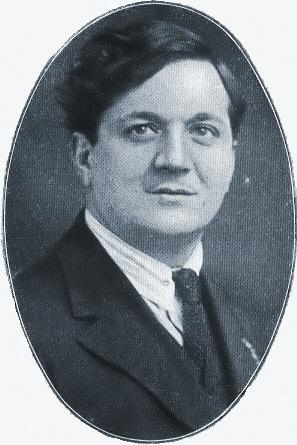
Boris Kostić
6332. Whose inscription? (C.N. 6309)
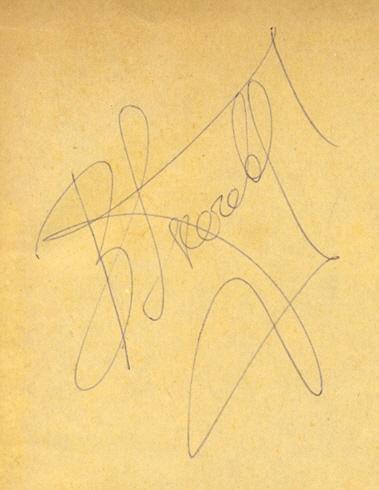
No reader identified the inscriber of our bound volume of the Revista Română de Şah, 1937: Vladislav Tkachiev.
6333. Masters’ reports on simultaneous displays (C.N. 6198)
In C.N. 6198 Nigel Short requested examples of magazine reports by leading masters on their simultaneous displays. No proposals having yet been received from readers, we point out the extensive series of articles by Emanuel Lasker entitled ‘My Journey’ which began on page 147 of Lasker’s Chess Magazine, February 1908. From page 197 of the March 1908 issue:
‘In my simultaneous exhibitions [in England] I encountered strong and weak players and made all sorts of combinations calculated to exercise the ingenuity of my audience. I consider such an exhibition in the light of an entertainment and do not measure the success gained by the score made. One should not try to play faultless chess on such an occasion; to begin with under the conditions of play one cannot succeed in that endeavor; then by immediately commencing brisk, if unsound, attacks, one runs the least chance of unduly prolonging the performance, and also presents many interesting and exciting positions to the spectator. Man is, of course, a creature of disposition, and sometimes I achieved only a succès d’estime. But mostly I did entertain players and audience for the space of about three hours very well.’
The second extract, from page 7 of the May 1908 issue, concerns a display which Lasker gave in The Hague on 9 May 1908:
‘I met 25 opponents simultaneously, but had no idea of their strength, since I did not know the best players except by name, nor knew they were playing. I cheerfully ventured on gambits and other rickety openings, and soon found myself in deplorable positions all around. The result was disaster. I won 11, drew 7 and lost 7, playing about four hours and a half.’
From page 66 of the July magazine, regarding a display in Leiden on 6 June 1908:
‘After some preliminaries, play started about a quarter of ten. The Dutch players, as usual, made a hard resistance, impossible to overcome by mere dash. To manoeuvre slowly on 25 boards is no easy matter, since purely strategic operations require, beside an “idea”, an immense attention to detail. So it was nearly three o’clock in the morning before all games were finished. The games had been interesting, but an entertainment of such long duration falls short of its purpose.’
6334. Havana Olympiad, 1966 (C.N.s 6299 & 6306)
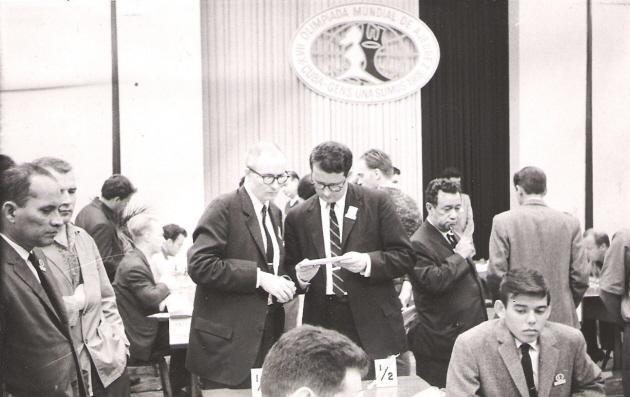
From Knud Lysdal (Grindsted, Denmark):
‘I believe that the player standing behind Donald Byrne is Bent Larsen. Børge Andersen is sitting at the table (behind Robert Byrne, to the left). Seated on his left is Sejer Holm-Petersen (who later changed his name to Sejer Holm). The photograph seems to have been taken during Denmark’s match against the German Democratic Republic on 11 November 1966, in which Larsen played Uhlmann on first board, and Andersen and Holm-Petersen played on boards three and four respectively.’
As recorded on page 279 of the tournament book, in that round the United States played Norway.
Bent Kølvig (Copenhagen, Denmark) concurs that Andersen and Holm are seated behind Robert Byrne.
6335. Turns of phrase
Good turns of phrase in chess literature are always welcome. On page 6 of 101 Brilliant Chess Miniatures (London, 1999) John Nunn mentioned having selected games which are ‘too recent to have been repeatedly anthologized and suffered the “death of a thousand annotations”.’
6336. Who?
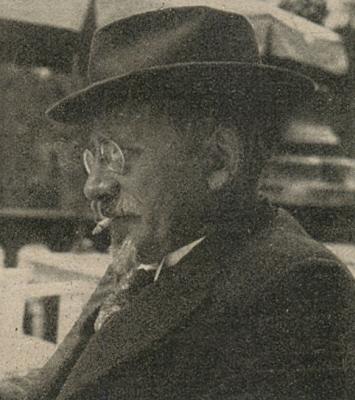
6337. Fischer on 5-5
Further to our feature article Capablanca v Alekhine, 1927 Christian Sánchez (Rosario, Argentina) writes:
‘In a letter published on page 715 of the November 1974 issue of Chess Life & Review Fischer wrote:
“... the Capa-Alekhine match did have a draw clause at 5-5. Yes, Alekhine had to win by 6-4 to take the title just the same as my match proposal ...
The Russians are also making a big to-do about this tie clause even though they are well aware from their own books of these facts. Yet they pretend that I’m asking for an unprecedented advantage! (See page 18 ‘Ten Champions of the World’, Moscow 1972 in Russian for Capa-Alekhine regulations – fotocopy enclosed.)”
The next page quotes a cable sent to FIDE by Fischer:
“... Alekhine needed at least a margin of six wins to four to become world champion, whereas Capablanca needed only five wins to retain his title, draws not counting ...”’
Below is an extract from pages 17-18 of the book
referred to by Fischer, 10 Chempionov Mira
edited by L. Abramov (the chapter in question having
been written by A. Kotov):

We shall be reverting to this topic in a future item.
6338. Youngest chess journalist
Mark N. Taylor (Mt Berry, GA, USA), who is the Editor of Georgia Chess, raises the subject of the youngest chess journalist:
‘Eleven-year-old Daniel Gurevich of Marietta, GA now writes the games column for Georgia Chess. This column has long been the centerpiece of the magazine. He is the current USCF National Elementary Champion and a strong expert player. For each issue he selects games to analyze from a database of recent local tournaments, finds a common theme and writes an introduction and discursive analysis. He also prepares nine puzzle positions from the same database. While the writing requires some editing (although no more than that of some adult contributors), it is all his own work.’
6339. Kashdan
From page 1 of Isaac Kashdan, American Chess Grandmaster by Peter P. Lahde (Jefferson, 2009):
‘Kashdan first learned the moves of chess at about age 17 while attending Stuyvesant High School, in New York City, in 1923.’
From page 7:
‘He learned chess at Stuyvesant High School in 1921.’
Above all, it is the ‘source lost’ reference on page 4, concerning Kashdan and Groucho Marx, which shows up the author’s casual approach to history.
With the carelessness (the name of the first person mentioned in the Acknowledgements section is misspelt), the staccato prose and the inadequate biographical research, the book is an uninspired addition to the McFarland chess list.
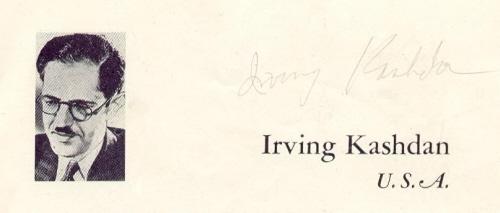
Our signed item above (Irving Kashdan) was discussed in C.N. 2794 (see pages 257-258 of Chess Facts and Fables).
6340. Grandmasters
Brian Karen (Levittown, NY, USA) writes:
‘Has there ever been a grandmaster who had a parent who was a grandmaster?’
6341. Dolo Falk (C.N. 4623)
Olimpiu G. Urcan (Singapore) has submitted two cuttings from the United States press:
A) The Times-Dispatch (Richmond, VA), 24 May 1903, page 4:
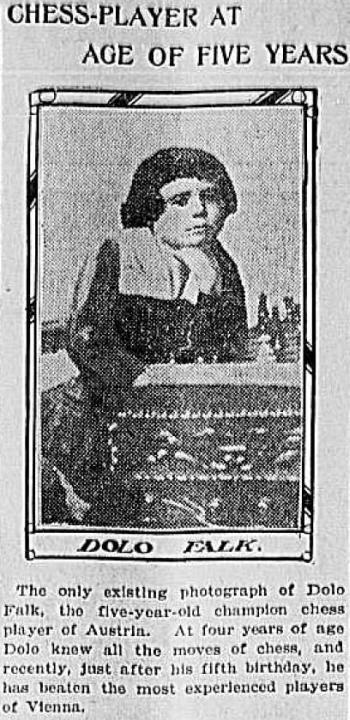
B) The Constitution (Atlanta, GA), 8 March 1903, page 4:
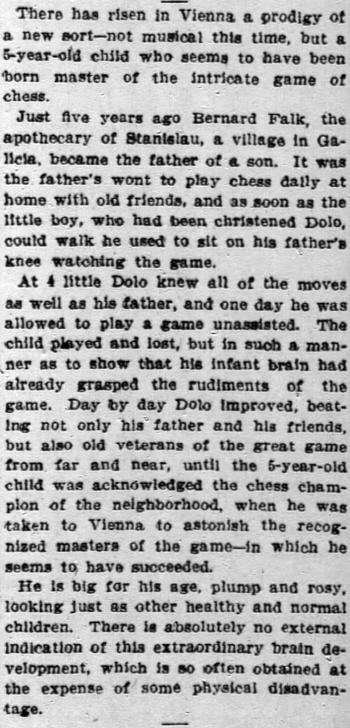
Mr Urcan also mentions that Dolo Falk was discussed by Tarrasch in the Berliner Lokal Anzeiger (see pages 194-196 of the Deutsche Schachzeitung, June 1903).
6342. J.C.H. Macbeth (C.N.s 4462 & 6325)
The book Chess Step by Step by F.J. Marshall and J.C.H. Macbeth (New York, 1924) is a further matter where A. Soltis’ 1994 monograph on Marshall (see C.N.s 4738 and 6266) went awry. On page 347 Soltis stated that Chess Step by Step ‘went into five printings’ and that another book written by Macbeth was Cryptography. Chess Step by Step had far more printings, the final one in our collection, the tenth, being dated November 1945. The author of Cryptography (London, 1922) was André Langie. As shown by our copy below, Macbeth was the translator (although he added a section at the end of the work):
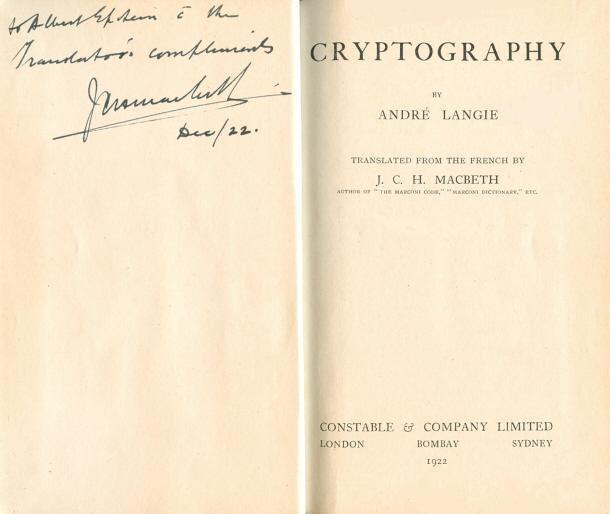
Published opinions on the Marshall/Macbeth book have varied widely. Soltis described it as ‘a routine introductory text of 306 pages’, whereas the book itself carried high praise from the Boston Herald: ‘the finest book on chess fundamentals ever written’.
6343. Who? (C.N. 6336)

This photograph, from page 81 of the March 1939 Tijdschrift van den Koninklijken Nederlandschen Schaakbond, shows G.C.A. Oskam.
6344. Aesthetically pleasing
A common piece of chess ‘wisdom’ is that good moves are pleasing on the eye, but when was this view first expressed? We note that it appeared on page 445 of Tarrasch’s Das Schachspiel (Berlin, 1931), concerning White’s opening play in Alekhine v Yates, London, 1922:
‘Die wirklich guten Züge sind auch fast immer, ich möchte sagen, ästhetisch schön.’
The English edition (page 359 of The Game of Chess) stated:
‘Really good moves are almost always, I might say, aesthetically pleasing.’
6345. Thierry Le Luron (C.N. 6256)
We have found a second photograph of Thierry Le Luron playing chess with Alice Sapritch, on page 34 of Femme Actuelle, 21-27 August 1995:
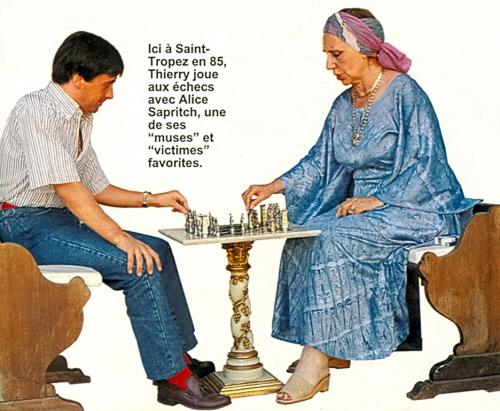
The caption says that the picture was taken in 1985, i.e. the year before he died.
6346. Havana Olympiad, 1966 (C.N.s 6299, 6306 & 6334)
From Thomas Binder (Berlin):
‘The player standing in the background on the left (behind Andersen and Holm) is Burkhard Malich.’
6347. Columbo
C.N. 1666 (an item reproduced on page 4 of Kings, Commoners and Knaves) gave the game W.J. Wolthuis v C.H.O’D. Alexander, Maastricht, 1946, which featured a position used in an episode of the television series Columbo, starring Peter Falk. See also C.N. 3986.
Readers’ help in obtaining some biographical information about Wolthuis will be appreciated. There was more than one player with that surname, and the photograph below (from the Groningen, 1946 tournament book by Euwe and Kmoch) shows H.J. Wolthuis:
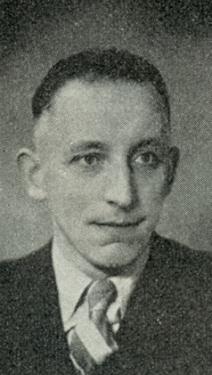
A picture of Peter Falk with Yasser Seirawan (as well as Larry Christiansen) appeared on the front cover of the December 1983 Chess Life:
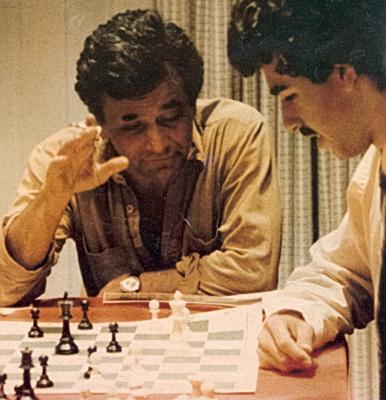
The cover also had a smaller photograph of Falk in conversation with Korchnoi.
6348. Alfred Kreymborg
Further to our feature article Alfred Kreymborg and Chess Jim Kulbacki (Cheyenne, WY, USA) draws attention to two other chess-related poems by Kreymborg. One of them is ‘Caïssa Nods’ on page 39 of his anthology The Lost Sail (New York, 1928):

The other poem is ‘Chess Players’, on pages 120-124 of Blood of Things (New York, 1920). We find it especially intriguing for two apparently prescient references to a player named Lilienthal. Here, for example, are the last few lines of the poem:
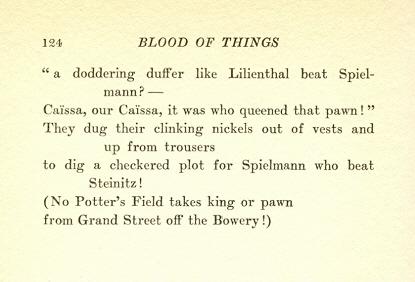
6349. Time-limit
Tony Gillam (Nottingham, England) points out a reference on page 63 of the 12 February 1911 issue of Deutsches Wochenschach to the time-limit at that year’s tournament in San Remo:
‘Gespielt wird täglich von 9½-2½ Uhr; die Bedenkzeit beträgt 45 Züge in 2½ Stunden, außerdem 3 Gnadenminuten.’
Thus apart from a limit of 45 moves in 2½ hours there existed ‘three minutes’ grace’. What is the exact meaning of that provision?
6350. Introspective account
John Blackstone (Las Vegas, NV, USA) notes pages 189-192 of Introduction to Psychology by Robert M. Yerkes (New York, 1911):
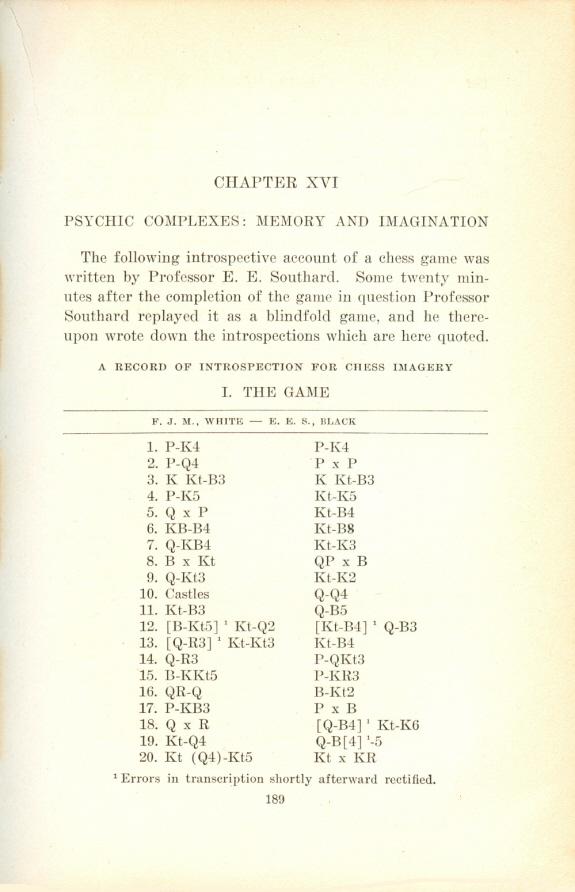
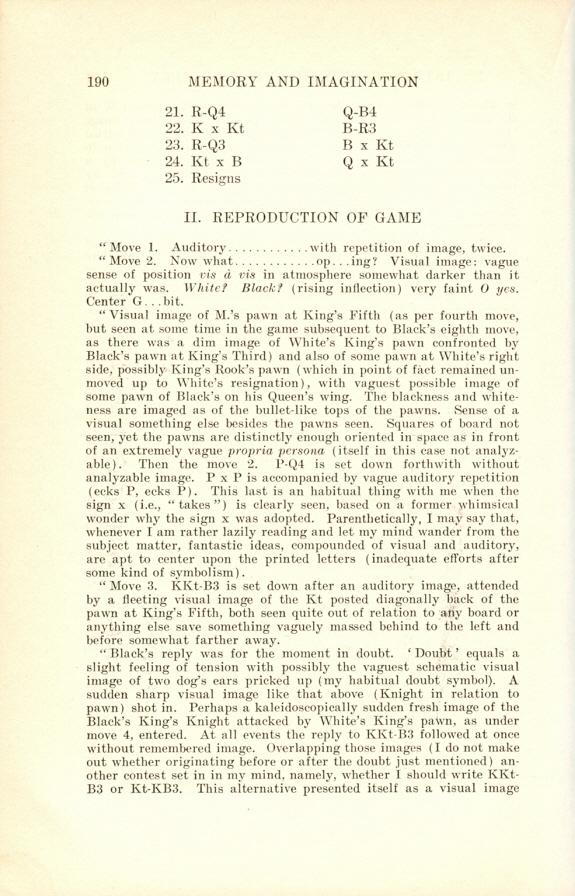
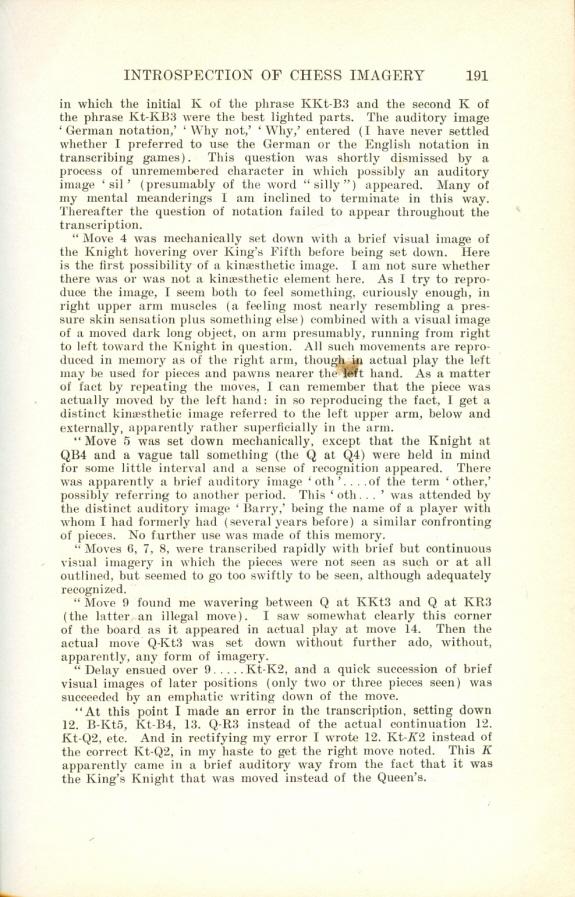
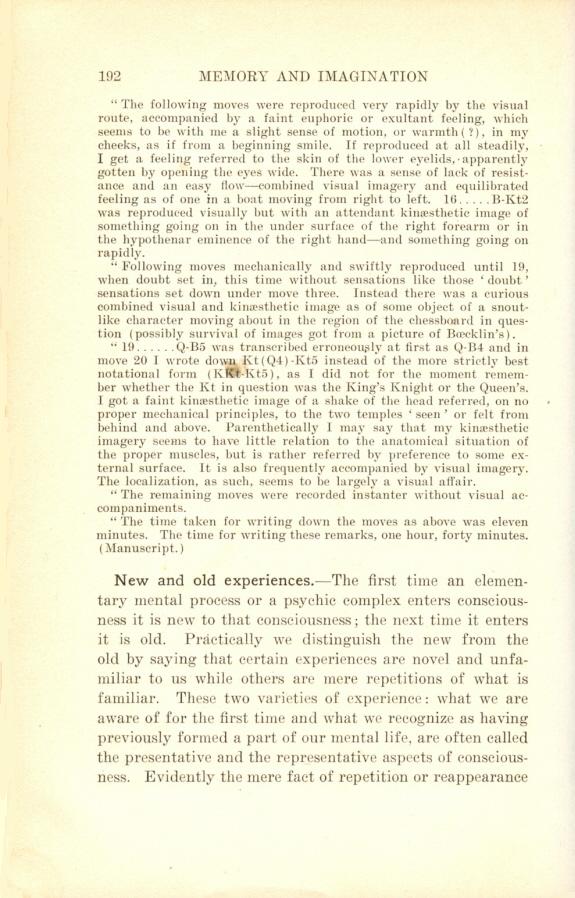
The game-score is: 1 e4 e5 2 d4 exd4 3 Nf3 Nf6 4 e5 Ne4 5 Qxd4 Nc5 6 Bc4 Nc6 7 Qf4 Ne6 8 Bxe6 dxe6 9 Qg3 Ne7 10 O-O Qd5 11 Nc3 Qc4 12 Nd2 Qc6 13 Nb3 Nf5 14 Qh3 b6 15 Bg5 h6
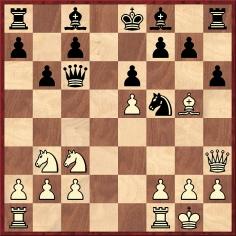
16 Rad1 Bb7 17 f3 hxg5 18 Qxh8 Ne3 19 Nd4 Qc4 20 Ndb5 Nxf1 21 Rd4 Qc5 22 Kxf1 Ba6 23 Rd3 Bxb5 24 Nxb5 Qxb5 25 White resigns.
More information on the game is sought. An immediate question is whether E.E. Southard’s opponent, ‘F.J.M.’, was Frank James Marshall.
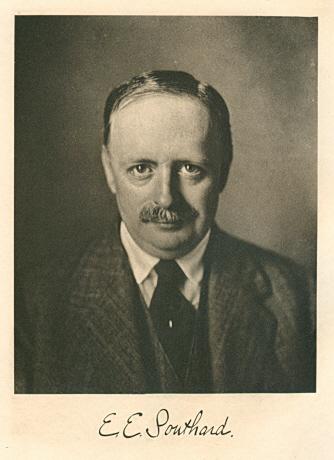
Elmer Ernest Southard
(1876-1920)
6351. Southard
The photograph at the end of C.N. 6350 was the frontispiece of the US publication Elmer Ernest Southard and His Parents by Myrtelle M. Canavan (Cambridge, 1925). It is one of three books mentioned to us by Rick Kennedy (Columbus, OH, USA), the others being a biography entitled The Open Mind: Elmer Ernest Southard 1876-1920 by Frederick P. Gay (Chicago, 1938) and a volume of which Southard was the co-author with H.C. Solomon, Neurosyphilis (Boston, 1917). Before offering information about these books, as well as some further jottings on Southard, we reproduce C.N. 2405:
From John S. Hilbert (Amherst, NY, USA):
‘Elmer Ernest Southard (1876-1920) played chess for Harvard University for four years, participating in the annual Princeton-Harvard-Yale-Columbia Intercollegiate chess tournaments during 1895-1899. He annually dominated play in these events, finishing his college career with a record 22-2 result. Southard’s distinguished professional career was cut short on 8 February 1920, when he died of pneumonia at the age of 43. His son, Ordway Southard, continued the association with chess, publishing Leaves of Chess a journal of scaccography from January 1957 through 1961.
In researching Elmer Southard’s chess career, I obtained his obituary in the New York Times for 9 February 1920. There we learn that Southard was “a member of the St Botolph and Boston Chess Clubs, and noted as one of the foremost amateur chess players in America. Dr Southard was particularly interested in the case of Harry N. Pillsbury, the former American champion chessplayer, who in the later years of his life lost his mind. Dr Southard made an examination and study of the brain of Pillsbury in an attempt to decide the mooted question of whether a genius for chess tends to deteriorate the mind.”
Had Dr Southard been a Freudian psychoanalyst, his examination of Pillsbury’s “brain” might well be written off as poor word choice by the Times writer responsible for the obituary. At the time of his death, though, he happened to be Bullard Professor of Neuropathology at Harvard Medical School, as well as pathologist to the Massachusetts Commission on Mental Diseases and a Director of the Massachusetts Psychiatric Institution. It appears that Pillsbury’s brain may actually have been in his hands.
Does anyone know if Dr Southard’s study of Pillsbury’s brain has survived, perhaps in the vast depths of Harvard’s libraries? Has anyone else seen Pillsbury’s brain?’
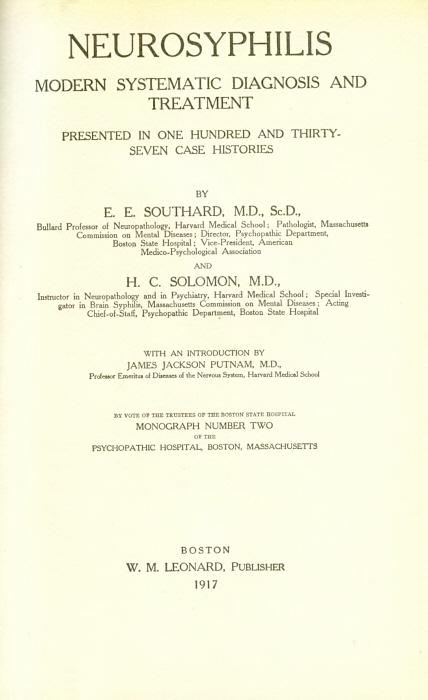
Neurosyphilis is a 496-page compendium of case histories. Page 17 states, ‘The names assigned to the cases are fictitious and chosen to suggest race or descent’, and we saw no biographical details corresponding to Pillsbury’s.
The above-mentioned book by Myrtelle M. Canavan is ‘a brain study’. Pages 9-10 comprise an autobiographical statement by Southard dated August 1917 which includes references to his enthusiasm for chess, while pages 11-19 present his medical history, including three detailed charts on the dimensions of his brain. The photographic plate on page 31 offers ‘six views of E.E. Southard’s brain’.
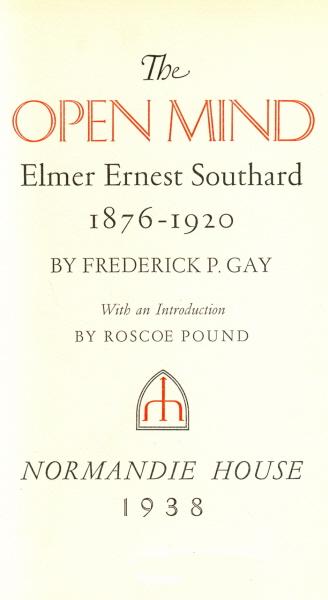
Frederick P. Gay’s The Open Mind has much information about Southard’s interest in chess, and particularly on pages 50-56. Part of page 50 is reproduced below:
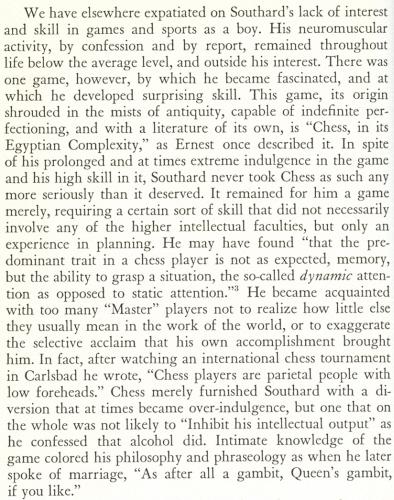
Page 52 states that Southard was able to play six or even eight blindfold games simultaneously, and the same page refers to his participation in the New York State Chess Association tournament at Trenton Falls in 1912. An appendix (pages 297-299) gives two games from the event, together with his use of ‘introspection for chess imagery’: victories as Black against W.J. Ferris and G.H. Walcott. The latter game is on page 229 of the October 1912 American Chess Bulletin, but Southard’s other win, with an unusual finish, was new to us:
William J. Ferris – Elmer Ernest SouthardTrenton Falls, August 1912
Queen’s Gambit Accepted
1 d4 d5 2 Nf3 Nf6 3 c4 dxc4 4 Nc3 c6 5 a4 Be6 6 Ne5 b5 (It may be wondered whether the opening moves were transcribed in the correct order.) 7 e3 Nd5 8 axb5 Nxc3 9 bxc3 cxb5 10 Qf3 Qd5 11 e4 Qd6 12 Bf4 Qb6 13 d5 f6 14 dxe6 fxe5 15 Qh5+ g6 16 Qxe5 Rg8 17 Rd1 Nc6 18 Qg5 Bg7 19 e5 Nd8 20 Qg4 Nxe6 21 Rd6 exd6 22 Qxe6+ Kf8 23 Be3 Qc7 24 f4 Re8 25 Qd5 Ke7 26 exd6+ Qxd6
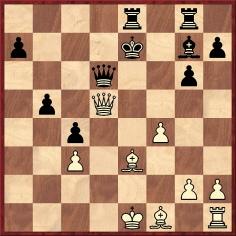
27 Bc5 Kd7+ 28 White resigns.
From page 53 of The Open Mind:
‘Throughout his life, particularly when on vacation, his letters are interspersed with accounts of chess games and his notes with the recording of games in which he has taken part. Thus he writes his wife from New York, October 1910, having drawn with and defeated Frank Marshall, for many years American champion, in two successive games.’
It will be recalled that a victory by Southard over ‘F.J.M.’ was given in C.N. 6350.
Page 54 states regarding Southard:
‘His ingenuity was shown in his analysis of what he quaintly called the Danvers Opening (1 P-K4 P-K4 2 Q-R5) showing that this childish-appearing line of play had far greater resources than had been thought. Here he showed his aversion to routine thinking and perhaps may be said to have anticipated by 15 years the discoveries of the hyper-modern school.’
A link to hypermodernism is hardly appropriate, but contemporary corroboration exists that Southard did indeed name the opening 1 e4 e5 2 Qh5 after the Danvers Insane Hospital. See pages 96-97 of Chess Explorations.
Two photographs from The Open Mind:
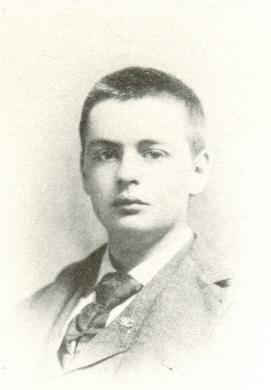 <
<
E.E. Southard (aged 17)
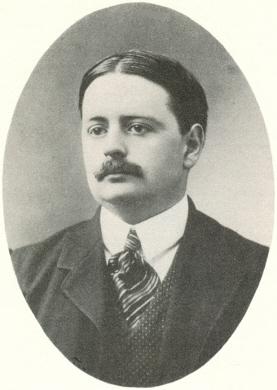
E.E. Southard (aged 25)
His obituary on page 46 of the March 1920 American Chess Bulletin is given below:
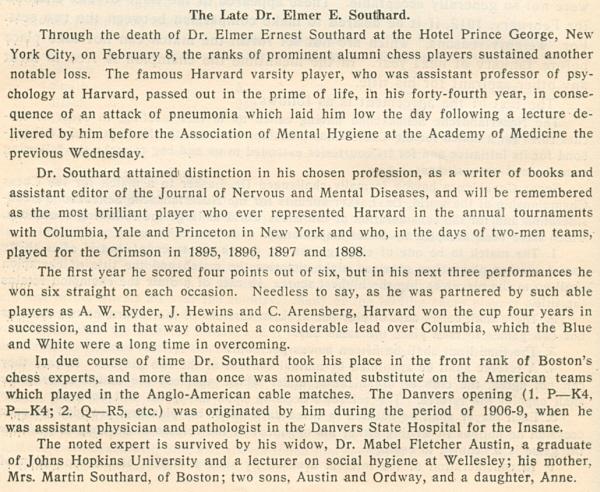
Our concluding photograph comes from page 2 of the first issue of Leaves of Chess, January-February 1957, which was edited by his son, Ordway:
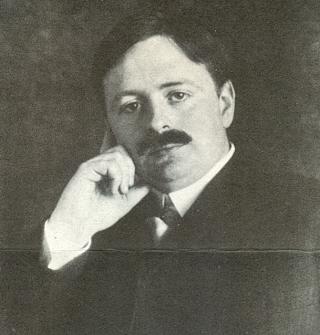
E.E. Southard
6352. Lisitsin’s Gambit
The earliest specimen of Lisitsin’s Gambit which we have noted:
Alfred Emil Wolf – Max WeissVienna, 12 May 1923
Lisitsin’s Gambit
1 Nf3 f5 2 e4 fxe4 3 Ng5 Nf6 4 d3 e3 5 fxe3 e5 6 Be2 d5 7 O-O Be7 8 Bh5+ g6 9 Nc3 O-O 10 Bf3 c6 11 e4 d4 12 Ne2 c5 13 c3 Nc6 14 Qb3+ Kg7 15 Ne6+ Bxe6 16 Qxe6 Qd7 17 Bg4 Qxe6 18 Bxe6 Rad8 19 cxd4 Nxd4 20 Nxd4 Rxd4 21 Rf3 Nh5 22 Rxf8 Bxf8 23 Bc4 Rd6 24 b4 Nf4 25 bxc5 Rd7 26 Bxf4 exf4 27 Bd5 Bxc5+ 28 Kf1 Kf6 29 Rc1 b6 30 Ke2 Ke5 31 Rc4 g5 32 Kd2 g4 33 Kc3 Rc7 34 Kd2 Be3+ 35 Ke2 Rxc4 36 Bxc4 h5 37 Bf7 h4 38 Bh5 Bg1 39 h3 gxh3 40 gxh3 Kd4 41 Bf7 b5 42 Bb3 a5 43 Kf3 Bh2 44 Bf7 Drawn.
Source: Wiener Schachzeitung, August 1923, pages 162-164.
Less than three months after playing the game, Wolf was
dead, aged 23. His annotations were included in the Wiener
Schachzeitung:

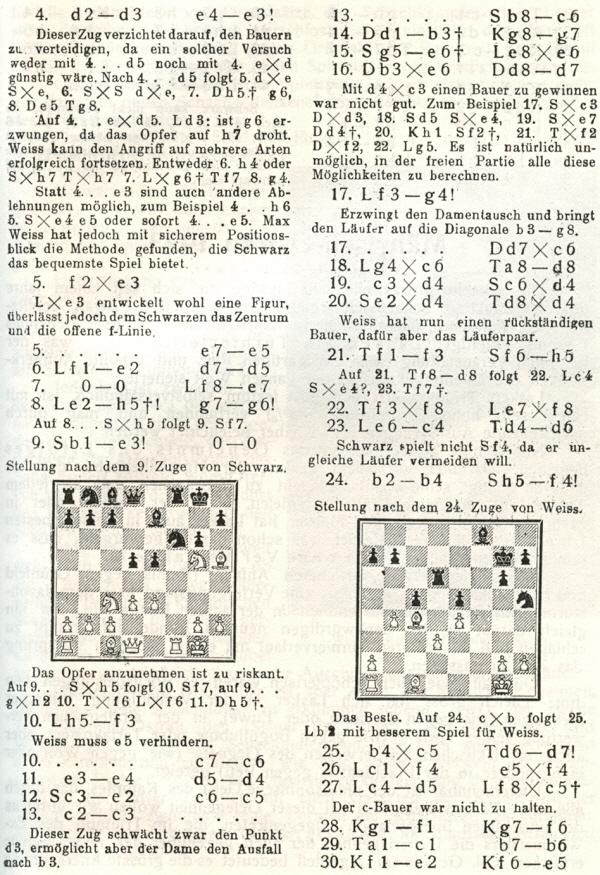
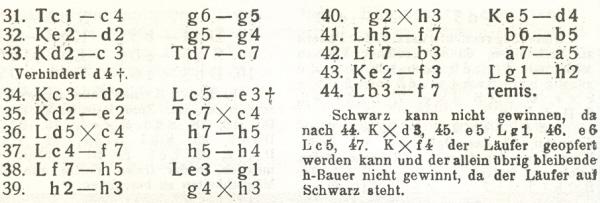
6353. Capablanca and who?
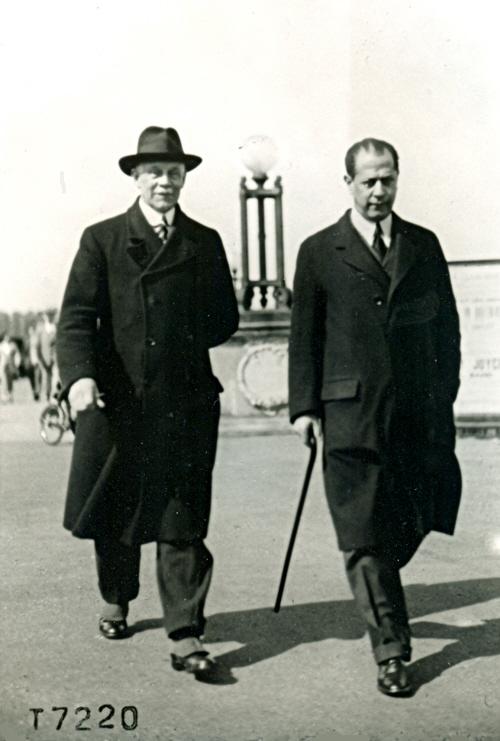
Information sought: who is pictured with Capablanca?
6354. ‘Alekhine v Nenarokov’
From page 127 of Winning Quickly at Chess by I. Neishtadt (London, 1997), after Tolush v Aronson, Moscow, 1957 has been given:
‘In 1967 it was reported in the Latvian magazine Shakhmaty that the score of a game won in 1907 by the young Alekhine against the Russian master Nenarokov had been discovered in the archives of a chess enthusiast. The game repeats move for move the above USSR Championship miniature.’
Over 20 years ago we published what may be regarded as overwhelming evidence that the 1907 claim was a fabrication. See The Alekhine v Nenarokov Hoax.
6355. Opočenský’s grave
Jan Kalendovský (Brno, Czech Republic) informs us that Václav Kotěšovec has found and photographed the grave of Karel Opočenský in the Friedhof Vinohrady, Prague:
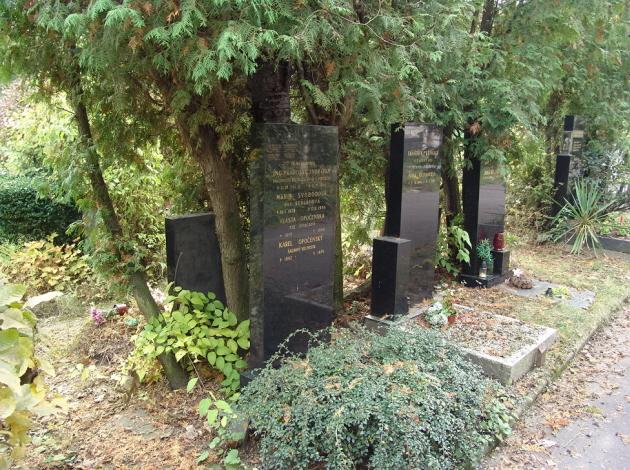
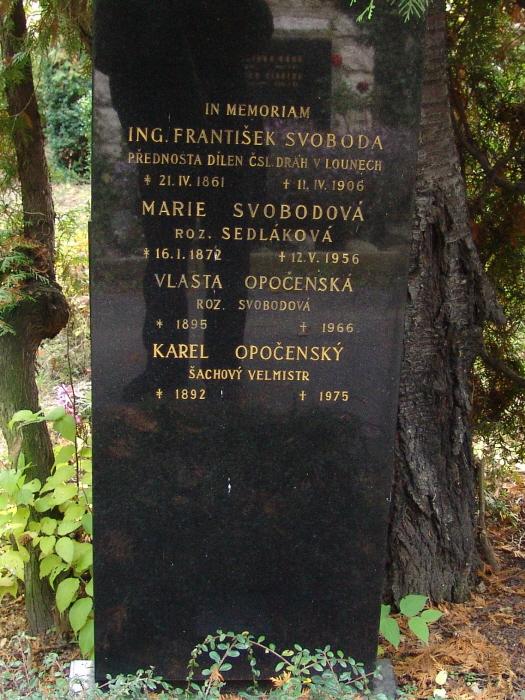
The photograph below is taken from Nad šachovnicemi celého světa by K. Opočenský and V. Houška (Prague, 1960):
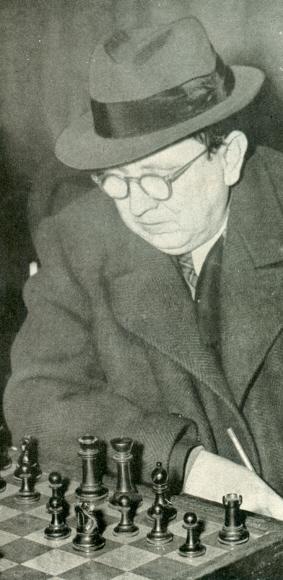
Karel Opočenský
6356. Marshall/Macbeth book (C.N.s 4462, 6325 & 6342)
We have now acquired an even later printing of Chess Step by Step, published in 1953. The imprint page lists 12 printings:
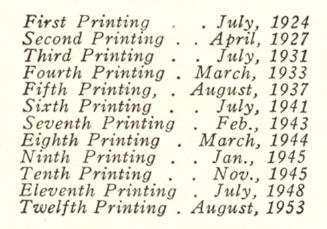
The final game (pages 289-291) is a rather elementary brevity lost by Marshall:
Richard Stutz – Frank James MarshallHandicap tournament, New York, 1915
(Odds of pawn and two moves. Remove Black’s f-pawn.)
1 e4 ... 2 d4 c5 3 e5 (‘This move is the invention of Mr Stutz, and the sacrifice of a pawn, followed eventually by another, constitutes the Stutz Gambit.’) 3...cxd4 4 Bd3 Qa5+ 5 Nd2 Qxe5+ 6 Ne4 Nc6 7 Nf3 Qa5+ 8 Bd2 Qc7 9 O-O Nf6 10 Re1 Nd5 11 Nfg5 g6 12 c4 dxc3 13 Bxc3
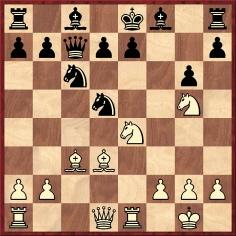
13...Nxc3 14 Nf6+ Resigns.
6357. Who?
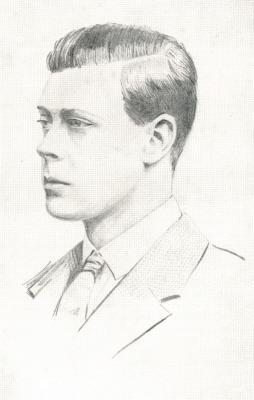
The above pencil sketch of the Duke of Windsor is by one of the chessplayers shown here:
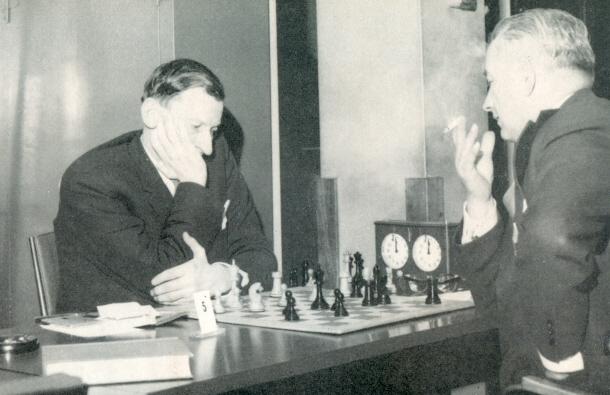
6358. Réti v Alekhine (C.N. 5632)
C.N. 5632 pointed out that three versions of the game Réti v Alekhine, Baden-Baden, 1925 have been found:
- A) 1 g3 e5 2 Nf3 e4 3 Nd4 d5 4 d3 exd3 5 Qxd3 Nf6 6 Bg2 Bb4+ 7 Bd2 Bxd2+ 8 Nxd2 O-O 9 c4 Na6 10 cxd5 Nb4 11 Qc4 Nbxd5 12 N2b3 c6 13 O-O Re8 14 Rfd1 Bg4 15 Rd2 Qc8 16 Nc5 Bh3 17 Bf3 Bg4 18 Bg2 Bh3 19 Bf3 Bg4 20 Bg2 Bh3 21 Bf3 Bg4 22 Bh1 h5 23 b4 a6 24 Rc1 h4 25 a4 hxg3 26 hxg3 Qc7 27 b5 axb5 28 axb5 Re3 29 Nf3 cxb5 30 Qxb5 Nc3 31 Qxb7 Qxb7 32 Nxb7 Nxe2+ 33 Kh2 Ne4 34 Rc4 Nxf2 35 Bg2 Be6 36 Rcc2 Ng4+ 37 Kh3 Ne5+ 38 Kh2 Rxf3 39 Rxe2 Ng4+ 40 Kh3 Ne3+ 41 Kh2 Nxc2 42 Bxf3 Nd4 43 White resigns.
The Baden-Baden tournament books by Tarrasch (Berlin, 1925) and by Caissa Editions (Yorklyn, 1991).
- B) 1 g3 e5 2 Nf3 e4 3 Nd4 d5 4 d3 exd3 5 Qxd3 Nf6 6 Bg2 Bb4+ 7 Bd2 Bxd2+ 8 Nxd2 O-O 9 c4 Na6 10 cxd5 Nb4 11 Qc4 Nbxd5 12 N2b3 c6 13 O-O Re8 14 Rfd1 Bg4 15 Rd2 Qc8 16 Nc5 Bh3 17 Bf3 Bg4 18 Bg2 Bh3 19 Bf3 Bg4 20 Bh1 h5 21 b4 a6 22 Rc1 h4 23 a4 hxg3 24 hxg3 Qc7 25 b5 axb5 26 axb5 Re3 27 Nf3 cxb5 28 Qxb5 Nc3 29 Qxb7 Qxb7 30 Nxb7 Nxe2+ 31 Kh2 Ne4 32 Rc4 Nxf2 33 Bg2 Be6 34 Rcc2 Ng4+ 35 Kh3 Ne5+ 36 Kh2 Rxf3 37 Rxe2 Ng4+ 38 Kh3 Ne3+ 39 Kh2 Nxc2 40 Bxf3 Nd4 41 White resigns.
Alekhine’s second volume of Best Games;
Auf dem Wege zur Weltmeisterschaft by Alekhine (Berlin and Leipzig, 1932);
Pages 100-101 of L’Echiquier, May 1925 (notes by Alekhine);
The Baden-Baden tournament book by N. Grekov (Moscow, 1927). It gave Alekhine’s annotations from Shakmaty, which were the same as those published in L’Echiquier;
G. Renaud, in L’Eclaireur du Soir, as reproduced on page 75 of the April 1925 L’Echiquier;
A. Rubinstein in La Nation Belge, as reproduced on page 124 of the June 1925 La Stratégie;
C.S. Howell in the American Chess Bulletin, May-June 1925, pages 94-95;
Les Cahiers de l’Echiquier Français, issue 6 (1926), page 182.
- C) 1 g3 e5 2 Nf3 e4 3 Nd4 d5 4 d3 exd3 5 Qxd3 Nf6 6 Bg2 Bb4+ 7 Bd2 Bxd2+ 8 Nxd2 O-O 9 c4 Na6 10 cxd5 Nb4 11 Qc4 Nbxd5 12 N2b3 c6 13 O-O Re8 14 Rfd1 Bg4 15 Rd2 Qc8 16 Nc5 Bh3 17 Bf3 Bg4 18 Bh1 h5 19 b4 a6 20 Rc1 h4 21 a4 hxg3 22 hxg3 Qc7 23 b5 axb5 24 axb5 Re3 25 Nf3 cxb5 26 Qxb5 Nc3 27 Qxb7 Qxb7 28 Nxb7 Nxe2+ 29 Kh2 Ne4 30 Rc4 Nxf2 31 Bg2 Be6 32 Rcc2 Ng4+ 33 Kh3 Ne5+ 34 Kh2 Rxf3 35 Rxe2 Ng4+ 36 Kh3 Ne3+ 37 Kh2 Nxc2 38 Bxf3 Nd4 39 White resigns.
R. Spielmann, Wiener Schachzeitung, May 1925, pages 135-136;
Deutsche Schachzeitung, May 1925, pages 147-148.
Thus the question was whether ...h5 was played at move 22, 20 or 18. Our item furthermore asked if Réti’s annotations to the game, in La Prensa (Buenos Aires), could be traced, and we are now grateful to Christian Sánchez (Rosario, Argentina) for providing them. He writes:
‘The game was played on 25 April 1925, and Réti’s analysis appeared on page 13 of the 28 April issue of La Prensa, his article being dated 27 April. Réti stated that ...h5 was played at move 22, Alekhine having offered a draw on the previous move.’
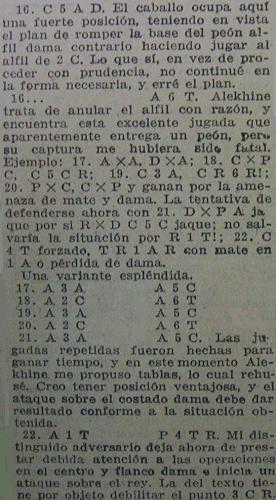
Mr Sánchez points out that Réti criticized three of his moves:
- Instead of 24 Rc1 he should have played 24 a4, then doubling rooks on the a-file and making the pawn-advance b5.
- 27 b5 was premature and his second error. It was necessary to play 27 e4.
- 29 Nf3 was the third mistake, and a fatal one. With 29 Bf3, Réti said, he would have had a good game.
6359. Signatures
From page 129 of the May 1939 Deutsche Schachzeitung:
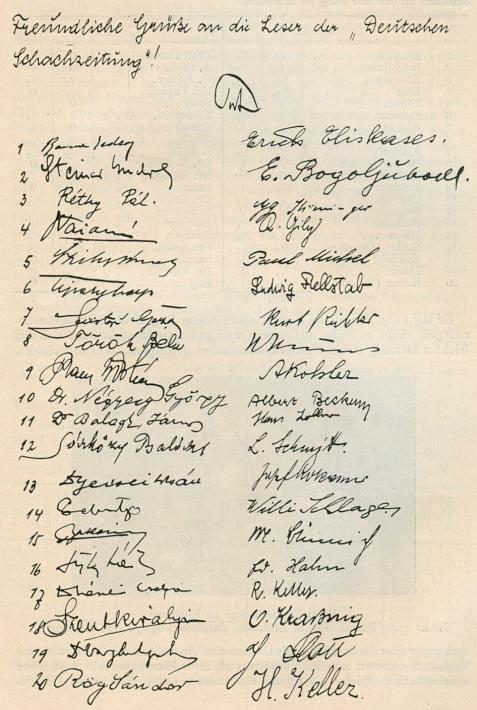
The players’ names were given on the following page:
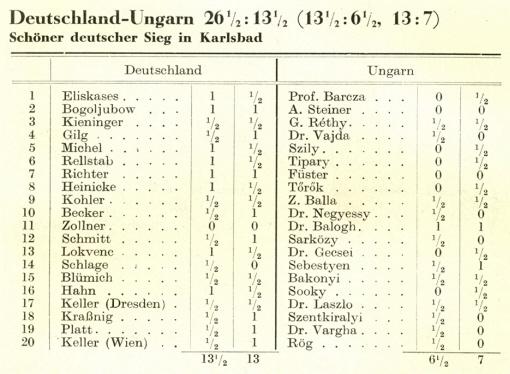
| First column | << previous | Archives [63] | next >> | Current column |
Copyright: Edward Winter. All rights reserved.